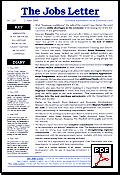



|
 |

|
| No.241 | 20 October 2005 | Essential Information on an Essential Issue |
of key events over the last few weeks. NEW MINISTER OF SOCIAL DEVELOPMENT AND EMPLOYMENT AIR NZ TO CUT 600 JOBS OIL PRICES AFFECTING NZ BUSINESSES WHAT IS DRIVING THE RISE IN PRICES? IS OIL PRODUCTION PEAKING? LEADERSHIP IN THE ERA OF DIMINISHING OIL MAYORS TASKFORCE CHANGES NELSON MAYORS FORUM HIGHLY SKILLED STILL HARD TO HIRE AGED-CARE WORKER STAFFING LEVELS TOO LOW HEALTHCARE WORKER SHORTAGE DEFENCE FORCES SHORT OF STAFF TRADES SHORTAGE AFFECTS SCHOOL TECHNOLOGY PROGRAMMES  LAST Letter
LAST Letter
NEXT Letter   Download this issue as a PDF file
Index to Features
24 September 2005The number of Americans filing for an unemployment benefit has risen as the scale of hurricane-related applications grows. 26 September 200550 jobs will go as the Meadow Fresh yoghurt factory in Christchurch closes and production shifts to another facility near Palmerston North. The decision to end Sunday trading at Carters building supplies stores will reduce pressure on staffing levels. Chief executive Stuart Monro says it has been harder to run a seven-day-a-week business because of low unemployment. 27 September 2005Perth's Royal Show offers free training courses for people looking for seasonal work. As part of a state government initiative to ease the skills shortage, courses are offered in areas like harvesting, seeding, shearing and mustering. 29 September 2005Australian Opposition leader Kim Beazley launches a "blueprint" focusing on skill shortages. Beazley says the skills blueprint includes a $2,000 tax-free bonus for people completing their apprenticeship. Beazley says that if the bonus halved the rate of people not completing apprenticeships, the country would benefit by getting 10,000 more skilled tradespeople per year. 30 September 2005Carter Holt Harvey announces 80 jobs will be lost by Christmas as the company plans to shut down its Rainbow Mountain sawmill operation. NZ hopes to double the number of Indian students at its tertiary institutions by running a series of educational recruitment fairs across nine Indian cities. Trade & Enterprise Commissioner Paul Vaughan tells Indian news service Chennai Online that with the low unemployment rates, NZ offered employment opportunities for students immediately after coming out from the universities. 1 October 2005Aged Care staffing levels are well below what the Ministry of Health considers safe according to an NZ Nurses Organisation report. The Immigration Service has received only 12 expressions of interest from people considering migrating to NZ as a business investor since toughened new rules were applied in June. The rules require would-be migrant investors to give the government $2 million, bonded for five years, after which they get their money back with an interest rate based on the rate of inflation. National Party MP Patsy Wong says migrants are instead choosing to go to Australia, Britain and Canada because they are getting the message they are not welcome in NZ. 3 October 2005Home ownership rates are projected to decline from 68% of households in 2001 to less than 62% in the next decade, according to Housing New Zealand. The home ownership drop is expected to create a huge demand for rental properties. 4 October 2005New Orleans City will lay off 3,000 council employees, or about 40% of its total payroll as it struggles to rebuild after the hurricane devastation. 5 October 2005The Western Australian government says mining companies are not doing enough to address the current shortage of skilled labour. Development Minister Alan Carpenter says the resources sector should be offering more support to attract people into science and minerals related courses and it's in the best interests of mining companies to invest in their potential future work force. 7 October 2005Latest Statistics NZ figures show the average weekly gross wages was up 4.2% for the year, slightly better than the average in the previous six years. 8 October 2005Mothers in poor NZ families are going without food to ensure their children are well fed, according to Otago University human nutritionist Dr Winsome Parnell. Parnell says 7% of NZ households have "food insecurity", mostly because they are poor. 11 October 2005NZ carpet manufacturer Feltex will cut 235 jobs, most of them in Australia. 30 of the redundancies will be at its Christchurch plant, while 205 jobs will be axed when the company closes its Braybrook plant in Melbourne. Reality television has robbed actors of more than 3,500 roles, or 10% of their livelihoods, according to Hollywood's main actors' union. 13 October 2005The Australian economy shed over 42,000 jobs last month and lifted the unemployment rate to 5.1%. 15 October 2005Over 300 NZ companies are represented at the Opportunities NZ Expo in London with the hope of recruiting skilled British and ex-patriot NZ workers. Expo director Hayley Roberts says 6,000 people came through the expo and most were skilled in areas of healthcare, engineering, accounting and finance, trades, IT/communications and business. 18 October 2005The Labour Party forms a government with the support of New Zealand First and the United Future Party, who gain Cabinet positions. The minimum wage is scheduled to rise from $9.50 to $12 per hour by 2008. The move is part of the deal that secured the New Zealand First Party's support for the Labour Party coalition government. Central North Island healthcare providers are looking for staff around the world using web-recruitment services. DHBs of Bay of Plenty, Lakes, Taiwhiti, Taranaki and Waikato currently have 110 vacancies listed here .
 LAST Diary
LAST Diary
NEXT Diary 
|
NEW MINISTER OF SOCIAL DEVELOPMENT AND EMPLOYMENT The Labour Party has finally put together a government 30 days after the national election.
The make up of the government unexpectedly includes New Zealand First and the United Future Party
and does not include Labour's closest ally during the election, the Green Party. Both New Zealand First
and the United Future refused to support a government that included Green MPs with Ministerial
responsibilities. The Labour Party has finally put together a government 30 days after the national election.
The make up of the government unexpectedly includes New Zealand First and the United Future Party
and does not include Labour's closest ally during the election, the Green Party. Both New Zealand First
and the United Future refused to support a government that included Green MPs with Ministerial
responsibilities.
When allocating Ministerial portfolios Prime Minister Helen Clark surprised many people when she appointed David Benson-Pope to succeed Steve Maharey as Minister Social Development and Employment. Benson-Pope is ranked 14th in the new Cabinet. His predecessor Maharey was ranked 4th. Source — media release NZ government, 19 October 2005, "Ministerial portfolios allocated".AIR NZ TO CUT 600 JOBS Record fuel prices have been blamed as a major reason for Air New Zealand's decision to
close its local workshops that do heavy maintenance on long-haul aircraft and engines. The decision may
cost as many as 600 jobs as Air NZ plans to trim $100 million from operation costs this year. Record fuel prices have been blamed as a major reason for Air New Zealand's decision to
close its local workshops that do heavy maintenance on long-haul aircraft and engines. The decision may
cost as many as 600 jobs as Air NZ plans to trim $100 million from operation costs this year.
Air NZ chief executive Rob Fyfe says the airline faces rising costs and increasing competition, particularly on trans-Tasman routes. It has increased its fuel surcharge four times since May last year because of rising jet fuel costs. Fuel makes up about 30% of the airline's costs now, up from 20% a year ago. The airline has faced declining volumes of engineering work due to the costs of getting planes to New Zealand, compared to cheaper options available when outsourcing the work to Asia and Europe. Air NZ estimates it will save $100m over five years by sending its own Boeing 747s, 767s and 777s overseas for maintenance rather than doing the work itself in New Zealand. The New Zealand Herald reports that Air NZ's heavy maintenance operation was, just four years ago, regarded as the "jewel in the crown" of what was otherwise a loss-making airline. But it is taking big hits from large overseas competitors, compounded by this country's remoteness. This has meant that the high proportion of overseas airlines business formerly using the heavy maintenance operation has all but dried up. Air NZ's chairman John Palmer says the decision to outsource maintenance was taken "with a very heavy heart". He told a shareholders annual meeting this week that fuel costs are estimated to increase by about $300 million on last year. The company will recover around $200 million through ticket surcharges, but such charges were likely to affect demand. Palmer warned the shareholders to expect a big tumble in profits this financial year, down from $235m in 2004-2005 to about $100m.  The 600 jobs will be trimmed from a maintenance workforce of 2,100. A final decision on
the level of job cuts will be made in December, but it is expected that the bulk of the cuts will be in
Auckland where the airline has about 1,400 maintenance engineers. There could also be up to 100 job
losses at the airline's Christchurch engineering facility. The 600 jobs will be trimmed from a maintenance workforce of 2,100. A final decision on
the level of job cuts will be made in December, but it is expected that the bulk of the cuts will be in
Auckland where the airline has about 1,400 maintenance engineers. There could also be up to 100 job
losses at the airline's Christchurch engineering facility.
The workers say they will plead to the government for intervention to save their jobs. (The government owns 82% of the airline after a $1 billion taxpayer bailout in 2001). They argue that the depth of the cuts to a highly skilled workforce, which they warn will be irreplaceable once disbanded, makes it an issue of national interest. A spokeswoman for Finance Minister Michael Cullen told the New Zealand Herald that he viewed Air NZ's announcement as "... entirely a matter for the company." Aviation and Marine Engineers Association general secretary George Ryde says many of those facing redundancy were recent recruits with student loans of up to $40,000. He called on the government to waive their loan repayments, at the very least. Source — Stuff website 19 October 2005 "Air NZ to cut 600 jobs" ; New Zealand Herald 20 October 2005 "Air NZ set to axe 617 jobs" by Matthew Dearnaley; Sydney Morning Herald 20 October 2005 "New Air NZ boss aims to sack 600 workers" by Scott RochfortOIL PRICES AFFECTING NZ BUSINESSES Another industry being battered by the rise in the cost of oil is New Zealand's inshore fishing
fleet. Diesel prices have risen from $.56 per litre in May 2004 to $1.05 and Nelson fishermen are spending up to half of their incomes to fuel their boats. With the unpredictability of catches, half the
small commercial fishing boats in Nelson are now staying tied-up in port rather than risking money by
putting out to sea. Another industry being battered by the rise in the cost of oil is New Zealand's inshore fishing
fleet. Diesel prices have risen from $.56 per litre in May 2004 to $1.05 and Nelson fishermen are spending up to half of their incomes to fuel their boats. With the unpredictability of catches, half the
small commercial fishing boats in Nelson are now staying tied-up in port rather than risking money by
putting out to sea.
The high cost of diesel is having the same effect on fishing businesses right around New Zealand and it's not just the smaller operators who are hurting. Port Nelson Fishing Association president Darren Guard points out that some of the larger vessels burn up to 300,000 litres of diesel for a six-week trip. Guard: "Now you put that in a dollar value and you tell me that doesn't hurt". One result is that the bottom has fallen out of the market for inshore commercial fishing boats. Nelson fisherman Alan Basalaj: "Nobody wants to get into this industry at the moment. You don't make money from it so why invest big money in it?" Source — TV One news, 30 June 2005, "Fishermen hit by diesel price" by Catherine Loft
Christchurch-based Delex Couriers runs a fleet of 14 owner-operator vans. Managing director Andrew Campbell says fuel-price rises have forced the company to increase fees— the first price rise in five years. Campbell says the company held off as long as possible: "But with prices steadily rising we couldn't carry the cost any longer." Source — The Press, 30 June 2005, "High fuel a drain on business", by Mike Houlahan and Beck Eleven;
WHAT IS DRIVING THE RISE IN PRICES?• In the past, oil prices have spiked as a result of political events. The price of petrol doubled when Arab countries withheld their oil in protest of the United States siding with Israel when it invaded Egypt in 1973. And petrol prices shot up again in 1979-80 when Iranian oil was taken off the world market due to the revolution in that country. Following those spikes, prices returned to previous levels. But never before has there been such a long, steady rise in the price of oil as a function of the market. The price of oil has risen from $30 per barrel in May 2004 to well over $60 per barrel today. The damage hurricanes Katrina and Rita did to oilrigs in the Gulf of Mexico and coastal United States refineries pushed prices up, but no one is holding the hurricanes responsible for the longer-term rising price of oil. Source — Media release Marathon Oil Company, 24 September 2005, "Marathon Oil Hurricane Rita Update #2; Science Daily 2 September 2005, "Georgia Researchers Project Hurricane Effects On Oil, Gas Production" by University of Central Florida.IS OIL PRODUCTION PEAKING? Dr Colin Campbell, a former senior oil industry exploration geologist and founder of the
Association for the Study of Peak Oil (ASPO), has plotted the production of oil and gas from 1930 to
2050, based on what is known about oil field productivity and trends in discovery. Campbell's
bell-curve diagram describes peak oil as occurring very soon. Campbell says that by 2007 oil production will
no longer be meeting demand — and never will again. The result will be a continual escalation in the
price of oil as the world's richest consumers bid for the diminishing resource. Campbell: "The scene is set
for the Second Great Depression … it is a situation without precedent." Dr Colin Campbell, a former senior oil industry exploration geologist and founder of the
Association for the Study of Peak Oil (ASPO), has plotted the production of oil and gas from 1930 to
2050, based on what is known about oil field productivity and trends in discovery. Campbell's
bell-curve diagram describes peak oil as occurring very soon. Campbell says that by 2007 oil production will
no longer be meeting demand — and never will again. The result will be a continual escalation in the
price of oil as the world's richest consumers bid for the diminishing resource. Campbell: "The scene is set
for the Second Great Depression … it is a situation without precedent."
Campbell: "Oil depletion is such a sensitive subject, which many people, especially those in government, prefer not to know about. But there are many solutions, especially in finding effective ways to use less, provided governments take effective action in time. It is too serious a subject to be left to the whims of an open market."  Click on image to go to Dr Colin Campbell's website
Source — A paper published by ASPO, 3 May 2005, "The Second Great Depression : Causes & Responses" by Colin J. Campbell; media release IEA, "Resources to Reserves - Oil and Gas Technologies for the Energy Markets of the Future". Financial Times, 4 August 2005, "Big Oil warns of coming energy crunch" by Carola Hoyos; media release IEA, 22 September 2005, "Resources to Reserves - Oil and Gas Technologies for the Energy Markets of the Future"; "Oil Depletion - Updated Through 2001" by C J Campbell.LEADERSHIP IN THE ERA OF DIMINISHING OILRichard Heinberg, lecturer and author of Power Down says that communities need to recognise the immensity of the problem and begin focusing their strategies to ease them through the transition out of the "oil age". Heinberg: "I have been travelling around the US speaking to city councils and citizen groups in various places about what can be done to size up vulnerabilities and strengths at the local level to begin dealing with the impacts of peak oil. The pain is going to be felt very largely at the local level, where people will no longer be able to get to work or to get to the store where they can buy their stuff. The stuff won't be getting to the store because the trucks won't be running. People will be having difficulty heating their homes. So these are problems that will have to be managed largely at the local level. And so city and county officials need to be alerted and need to be strategizing and planning for long-term — finding ways to produce food, more food at the local level for local consumption, making sure that local water supplies are tied to energy sources that are not vulnerable to this problem." Source — Richard Heinberg at the Roscoe Barlett Energy Conference, 26 September 2005.
 MAYORS TASKFORCE CHANGES Changes at the Mayors
Taskforce. The Mayors Taskforce for Jobs has a new
chairperson following the resignation of its founding chair Garry Moore, the Mayor of Christchurch. Moore
has been succeeded by the Taskforce deputy chair Paul Matheson, the Mayor of Nelson. Moore says
that with growing demands on his time both as Mayor of Christchurch and as chairman of the Taskforce,
he has had to cut back on his commitments. He will remain on the core group of the Taskforce. Changes at the Mayors
Taskforce. The Mayors Taskforce for Jobs has a new
chairperson following the resignation of its founding chair Garry Moore, the Mayor of Christchurch. Moore
has been succeeded by the Taskforce deputy chair Paul Matheson, the Mayor of Nelson. Moore says
that with growing demands on his time both as Mayor of Christchurch and as chairman of the Taskforce,
he has had to cut back on his commitments. He will remain on the core group of the Taskforce.
Moore has put an enormous amount of time and energy into creating the Taskforce, and under his leadership the initiative has grown from a small group of seven Mayors to 67 Mayors (or 90% of all Mayors in New Zealand). Just this year, Moore also led a deputation of Mayors to Australia to encourage a group of New South Wales Mayors establish a similar initiative. New Taskforce chairman Paul Matheson says he is keen to take on the role and lead the work towards guaranteeing all young people a bright and prosperous future in New Zealand. Matheson: "The power and strength of the Taskforce is in our collective ability as Mayors to speak to the whole community, take civic leadership and facilitate the collaboration and genuine partnerships across all sectors, which is so crucial to our vision ... The Mayors' goal is already supported in most communities by many big businesses and by parents and families everywhere. I look forward to working with our partners and continuing the great work of all those involved with the Taskforce."
NELSON MAYORS FORUM The Mayors Taskforce will be holding a major public forum in Nelson on 15 and 16
November 2005. "People Connecting : Connecting People"
is the theme which will see Mayors meeting
with representatives from local authorities, government departments and community groups.
Keynote speakers include Principal Youth Court Judge Andrew Becroft; Mike Smith, General Manager
of Regional Operations at the Ministry of Social Development; and Celia Lashlie, project facilitator of
the Nelson/Tasman Connections programme. Professor Ian Shirley from the Institute of Public Policy
will also give a progress report on Taskforce commissioned research into Youth and Job Guarantees. The Mayors Taskforce will be holding a major public forum in Nelson on 15 and 16
November 2005. "People Connecting : Connecting People"
is the theme which will see Mayors meeting
with representatives from local authorities, government departments and community groups.
Keynote speakers include Principal Youth Court Judge Andrew Becroft; Mike Smith, General Manager
of Regional Operations at the Ministry of Social Development; and Celia Lashlie, project facilitator of
the Nelson/Tasman Connections programme. Professor Ian Shirley from the Institute of Public Policy
will also give a progress report on Taskforce commissioned research into Youth and Job Guarantees.
HIGHLY SKILLED STILL HARD TO HIREHowever, employers looking for highly skilled workers are continuing to find their task difficult. The Job Vacancy Monitor found that highly skilled workers — including engineers, health workers, teachers, lawyers, architects and accountants — rose 24% since this time last year. And job vacancies rose a huge 54% in the information technology sector. — the Job Vacancy Monitor can be found here. Source — New Zealand Herald, 7 October 2005, "Demand rising for top job skills" by NZPA; media release by Department of Labour, 6 October 2005, "Skill shortages easing; sector disparities".AGED-CARE WORKER STAFFING LEVELS TOO LOW Staffing levels in aged-care facilities around the country are well below Ministry of
Health-supported guidelines. A "snapshot" of a variety of aged-care sites, taken by New Zealand Nurses
Organisation (NZNO) delegates, found "clear and consistent evidence of understaffing" across nearly
all sectors and groups. Based on levels recommended in a Standards New Zealand booklet published
in 2004, the NZNO found nurse staffing and caregiver staffing at rest homes to be at about half the
recommended safe staffing levels for aged-care and dementia-care facilities. And in aged-care
hospitals, nursing numbers were at 62% of the number needed, and less qualified staff — caregivers and
enrolled nurses — appeared to be filling in for registered nurses. Staffing levels in aged-care facilities around the country are well below Ministry of
Health-supported guidelines. A "snapshot" of a variety of aged-care sites, taken by New Zealand Nurses
Organisation (NZNO) delegates, found "clear and consistent evidence of understaffing" across nearly
all sectors and groups. Based on levels recommended in a Standards New Zealand booklet published
in 2004, the NZNO found nurse staffing and caregiver staffing at rest homes to be at about half the
recommended safe staffing levels for aged-care and dementia-care facilities. And in aged-care
hospitals, nursing numbers were at 62% of the number needed, and less qualified staff — caregivers and
enrolled nurses — appeared to be filling in for registered nurses.
The NZNO calls for re-establishment of minimum staffing level standards. Spokesperson Cee Payne-Harker says that at the time the Standards NZ handbook was issued, the establishment of minimum staffing levels was opposed because an accompanying report stated that `most providers already work within the recommended staffing levels', and thus there was no need to enforce staffing level minimums. Payne-Harker says this is clearly not so and the government needs to provide substantially more money to the sector, specifically for improving staff wages and conditions, and to set minimum staffing levels. Payne-Harker: "It's at crisis point and the crisis is deepening." Source — Media release NZNO, 3 October 2005, "Staffing Levels in Aged Care Below Ministry Guidelines"; Herald on Sunday, 2 October 2005, "Aged suffer in staff crisis" by Amanda Cameron.
HEALTHCARE WORKER SHORTAGESource — Media release Health And Disability Group, 30 September 2005, "Aging population faces health workforce crisis".DEFENCE FORCES SHORT OF STAFF The strong labour market is making it difficult for New Zealand's armed services to compete
with other sectors and attract quality recruits. The staffing level in the armed services is down 40%
since 1990 and is currently understaffed by about 2,500 people. It has struggled to retain experienced
officers, troops and personnel in key trades and shortages are critical. Because it is so short of staff, the
armed forces is reconfiguring itself in order to retain its abilities as a fighting force. The strong labour market is making it difficult for New Zealand's armed services to compete
with other sectors and attract quality recruits. The staffing level in the armed services is down 40%
since 1990 and is currently understaffed by about 2,500 people. It has struggled to retain experienced
officers, troops and personnel in key trades and shortages are critical. Because it is so short of staff, the
armed forces is reconfiguring itself in order to retain its abilities as a fighting force.
Chief of Defence Force Air Marshall Bruce Ferguson says the recovery of personnel numbers will be a high priority over the next three years. But at current attrition rates —and recruiting targets — Ferguson expects it will take up to 10 years to increase the Defence Forces to the desired strength with people who have the required skills and experience. Source — New Zealand Herald, 29 September 2005, "10 years to fix armed forces staff" by Kevin Taylor; The Dominion Post, 17 October 2005 "Army 2000 troops below strength" by Hank Schouten
TRADES SHORTAGE AFFECTS SCHOOL TECHNOLOGY PROGRAMMESPost Primary Teachers Association president Debbie Te Whaiti says too few technology graduates are entering teaching as trade shortages meant many could earn more working in industry. Source — Dominion Post, 11 October 2005, "Teaching technology hit by lack of tradesmen" by Michelle Quirke. |